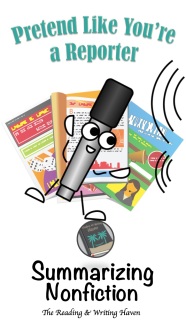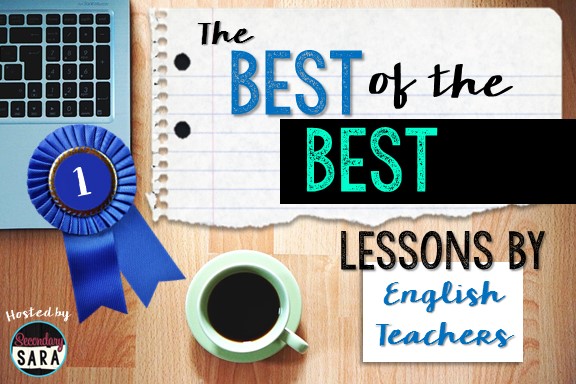Have you ever noticed how easy it is to teach students to summarize fictional texts? They seem to catch on so quickly! Maybe it’s because the plot guides the summary, and all of the parts of the story work together sensibly. Exposition. Rising Action. Climax. Falling Action. Resolution. Simple, right?
If only nonfiction was equally as straightforward! Unfortunately, I’m not going to tell you there’s a secret formula that will make students go from zero to hero when it comes to written nonfiction summarizing skills, but I do have some concrete, useful ideas and strategies to help reduce both student and teacher frustration.
One of the reasons I love teaching summarizing is because, as a certified Reading Specialist, I know how important it is for skillful comprehension…not only in English class but in all subject areas. If your little cherubs can give you the main ideas and most important supporting details of a text in an accurate and coherent manner, they are well on their way to being masters of cognition.
So let’s cut to the chase. Here are a few tips to simplify your summarizing instruction when it comes to nonfiction, non-narrative texts:

- Start by picking high-interest texts. Believe me, I know how tempting it is to select a text about the deliciousness of coffee because of your love affair with it (…or maybe that’s mine), but resist the urge! Research says that if kids don’t care about the text, they will most likely not invest themselves in it. One of my go-to sources is Newsela because it differentiates the lexile levels of the articles and provides other useful teacher resources. My students also really enjoy Scholastic and Upfront magazines. Another one I recently stumbled upon is Curriculet, which I absolutely adore. Check it out if you haven’t.
- Begin with direct instruction. While people possess differing opinions on the value of direct instruction, I have seen its benefit when introducing new information. Keep it short, but give an overview of the down and dirty tips you expect your peeps to remember. Make them take notes. They’ll thank you later.
- Model, model, and then model like Cindy Crawford. Students need to see you working your mojo. Select a short text. Read it or watch it together (students love visual texts). Then, do a think-aloud while you model some brainstorming and writing up on the board. Students generally want to get involved in this process. Let them! If you are uncomfortable with writing on your feet, prepare something in advance and act like you are doing it on the spot. Don’t worry; they’ll never know the difference. What’s important is that they see the internal thought process played out aloud.
- Scaffold. Direct instruction – guided practice – independent practice. This is just common sense. After you model, practice as many times as you deem necessary with
the class. Write a summary together, put them in small groups, let them complete a think-pair-share summary for a different text, and then finally, throw those baby birds out of the nest and see if they fly or splat on the ground. If they come up looking at a “Snort” and think it’s their mother, it’s time to put them back in the nest for more guided practice. - Chunk your instruction. As with any effectively taught lesson, students need breaks. I try to chunk my instruction into three different parts in a forty-five minute period. If I have an activity that takes longer than 20 minutes, I use brain breaks periodically throughout the lesson. Even having students get up and grab a piece of paper from across the room helps get their blood flowing, increases their energy levels, and improves their focus. What does this look like with summarizing? Maybe read a text, then have them discuss it with a partner or small group. Following, they could get up and grab the graphic organizer from across the room. You might end the period with a whole-class discussion about what to include in the written summary. Students can stand to share their ideas.
- Assess. Obviously, you’re assessing throughout the entire process by asking questions, checking their written ideas, and listening to their conversations. Still, I like to do a formal assessment at the end of the unit, in which I include two things: 1) questions about the process of summarizing nonfiction (like, List three different elements to include in a nonfiction summary.), and 2) a written portion where students read a nonfiction text and write a summary on their own – sans help! At this point, I would expect them to demonstrate mastery.
And, voila! As they say, keep it simple.
When it comes to summarizing nonfiction, remember that answers will vary. What you’re really looking for is whether or not students can read a nonfiction text and then provide you with the main ideas and most important supporting details in a clear, objective, intelligent manner. Give students praise for everything they do well, and they’ll have more fun along the way.
I hope these ideas help you and your students. Please leave a comment or send me an e-mail if you have clever ideas for summarizing nonfiction texts that you’d like to share!
If you would like to view my super fabulous, research-based nonfiction summarizing materials that will provide you with everything you need to tackle the tips above, please check out my nonfiction summarizing bundle, which is my favorite product right now.
Take a look at these other amazing educators and their favorite teaching tools by clicking on the link below.





Oh, I haven’t heard of Curriculet! I will check that out for sure! I LOVE reading and teaching nonfiction, so thank you for this post!
LikeLiked by 1 person
Yes, do! It has great teacher resources and levels texts for students’ reading abilities.
LikeLike
Hah! I could read your writing all day long – “Model like Cindy Crawford,” “throw those baby birds out of the nest” etc. LOVE IT!
Thanks so much for sharing these amazing tips.
LikeLiked by 1 person
Very kind of you…thanks so much for reading!
LikeLike
Thank you for sharing your steps for teaching summarizing in non-fiction texts. I follow a very similar method in my own classroom and have seen tremendous results from it as well. You hit the nail on the head when you said that this is a skill that is critical because it transfers to all other subject areas. I definitely think that this is blog post that all ELA teachers need to see!
LikeLiked by 1 person
Thanks for the validation!
LikeLike
Great tips! I especially support use of high interest non-fiction texts. I’ll have to look at your links. One topic that has never failed to interest my students is Criminals (think Al Capone, Bonnie and Clyde). The old articles and sources I’ve used are often challenging because of the old writing, but they dive in because the subject catches their attention!
LikeLiked by 1 person
Thanks for the idea for criminal topics…I haven’t tried that, but I’m sure my students would also find it fascinating.
LikeLike
Such a well written explanation of GOOD teaching. Your student are lucky to have you. I too am a reading recovery teacher and summarizing is paramount. Thank you for sharing.
LikeLiked by 1 person
Thanks for your kind words!
LikeLike
I agree with Kim! Looks like a lot of good teaching is happening in your classroom.
LikeLiked by 1 person
You’re hilarious – model like Cindy Crawford. I might say that to my students. Thanks for all the ideas – and I agree – providing examples reduces frustration all around.
LikeLiked by 1 person
You’ve got some great tips compiled here! Thank you for sharing.
LikeLike
This is so thorough! Thanks for the great ideas. As simple as it seems to us, summarizing nonfiction can be challenging for many students. I loved the comment about coffee texts…”Believe me, I know how tempting it is to select a text about the deliciousness of coffee because of your love affair with it (…or maybe that’s mine), but resist the urge!” I can identify with your love for coffee, and I wholeheartedly agree that interest is oftentimes the #1 factor in texting nonfiction texts!
LikeLike
I love the structure for your lessons! I can imagine the fun if you actually put up a picture of Cindy Crawford while you were “modeling”! 🙂
LikeLike